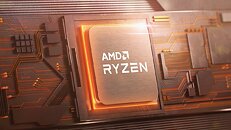- Joined
- Oct 9, 2007
- Messages
- 47,598 (7.45/day)
- Location
- Dublin, Ireland
| System Name | RBMK-1000 |
|---|---|
| Processor | AMD Ryzen 7 5700G |
| Motherboard | Gigabyte B550 AORUS Elite V2 |
| Cooling | DeepCool Gammax L240 V2 |
| Memory | 2x 16GB DDR4-3200 |
| Video Card(s) | Galax RTX 4070 Ti EX |
| Storage | Samsung 990 1TB |
| Display(s) | BenQ 1440p 60 Hz 27-inch |
| Case | Corsair Carbide 100R |
| Audio Device(s) | ASUS SupremeFX S1220A |
| Power Supply | Cooler Master MWE Gold 650W |
| Mouse | ASUS ROG Strix Impact |
| Keyboard | Gamdias Hermes E2 |
| Software | Windows 11 Pro |
AMD in its 2022 Financial Analyst Day presentation announced the codename for the second generation of Ryzen desktop processors for Socket AM5, which is "Granite Ridge." A successor to the Ryzen 7000 "Raphael," the next-generation "Granite Ridge" processor will incorporate the "Zen 5" CPU microarchitecture, with its CPU complex dies (CCDs) built on the 4 nm silicon fabrication node. "Zen 5" will feature several core-level designs as detailed in our older article, including a redesigned front-end with greater parallelism, which should indicate a much large execution stage. The architecture could also incorporate AI/ML performance enhancements as AMD taps into Xilinx IP to add more fixed-function hardware backing the AI/ML capabilities of its processors.
The "Zen 5" microarchitecture makes its client debut with Ryzen "Granite Ridge," and server debut with EPYC "Turin." It's being speculated that AMD could give "Turin" a round of CPU core-count increases, while retaining the same SP5 infrastructure; which means we could see either smaller CCDs, or higher core-count per CCD with "Zen 5." Much like "Raphael," the next-gen "Granite Ridge" will be a series of high core-count desktop processors that will feature a functional iGPU that's good enough for desktop/productivity, though not gaming. AMD confirmed that it doesn't see "Raphael" as an APU, and that its definition of an "APU" is a processor with a large iGPU that's capable of gaming. The company's next such APU will be "Phoenix Point."

The "Phoenix Point" silicon has been grinding through the rumor-mill for a couple of months now. It is rumored to be a monolithic die built on TSMC N5 (5 nm), feature a "Zen 4" CCX, a powerful iGPU based on the next-gen RDNA3 graphics architecture, DDR5 memory, and possibly PCI-Express Gen 5. The silicon could make its debut as a mobile processor first, followed by a desktop product in the AM5 package. From its Financial Analyst Day presentation, we don't gather AMD bringing "Rembrandt" to AM5, but something like that can't be ruled out for the entry/mainstream Ryzen 3 and Ryzen 5 segments. "Rembrandt" uses an older "Zen 3+" CCX.
"Phoenix Point" integrates what AMD calls an AIE (AI inference accelerator), which could be the much talked about hardware-acceleration component the company has been hinting at, for which it will draw IP and talent from its recently acquired Xilinx team. AIE and Infinity Fabric come together to form XDNA, the first AI-acceleration FPGA architecture by Xilinx, post its acquisition by AMD. XDNA will be found not just in client chips such as "Phoenix Point," but also server processors like "Turin," and super-scalar compute processors based on CDNA3.
The successor to "Phoenix Point" will be "Strix Point," which could see the integration of "Zen 5" CPU cores, a faster RDNA3 iGPU, XDNA AIE, and more. "Strix Point" is slated for 2023-24.
View at TechPowerUp Main Site
The "Zen 5" microarchitecture makes its client debut with Ryzen "Granite Ridge," and server debut with EPYC "Turin." It's being speculated that AMD could give "Turin" a round of CPU core-count increases, while retaining the same SP5 infrastructure; which means we could see either smaller CCDs, or higher core-count per CCD with "Zen 5." Much like "Raphael," the next-gen "Granite Ridge" will be a series of high core-count desktop processors that will feature a functional iGPU that's good enough for desktop/productivity, though not gaming. AMD confirmed that it doesn't see "Raphael" as an APU, and that its definition of an "APU" is a processor with a large iGPU that's capable of gaming. The company's next such APU will be "Phoenix Point."

The "Phoenix Point" silicon has been grinding through the rumor-mill for a couple of months now. It is rumored to be a monolithic die built on TSMC N5 (5 nm), feature a "Zen 4" CCX, a powerful iGPU based on the next-gen RDNA3 graphics architecture, DDR5 memory, and possibly PCI-Express Gen 5. The silicon could make its debut as a mobile processor first, followed by a desktop product in the AM5 package. From its Financial Analyst Day presentation, we don't gather AMD bringing "Rembrandt" to AM5, but something like that can't be ruled out for the entry/mainstream Ryzen 3 and Ryzen 5 segments. "Rembrandt" uses an older "Zen 3+" CCX.
"Phoenix Point" integrates what AMD calls an AIE (AI inference accelerator), which could be the much talked about hardware-acceleration component the company has been hinting at, for which it will draw IP and talent from its recently acquired Xilinx team. AIE and Infinity Fabric come together to form XDNA, the first AI-acceleration FPGA architecture by Xilinx, post its acquisition by AMD. XDNA will be found not just in client chips such as "Phoenix Point," but also server processors like "Turin," and super-scalar compute processors based on CDNA3.
The successor to "Phoenix Point" will be "Strix Point," which could see the integration of "Zen 5" CPU cores, a faster RDNA3 iGPU, XDNA AIE, and more. "Strix Point" is slated for 2023-24.
View at TechPowerUp Main Site



